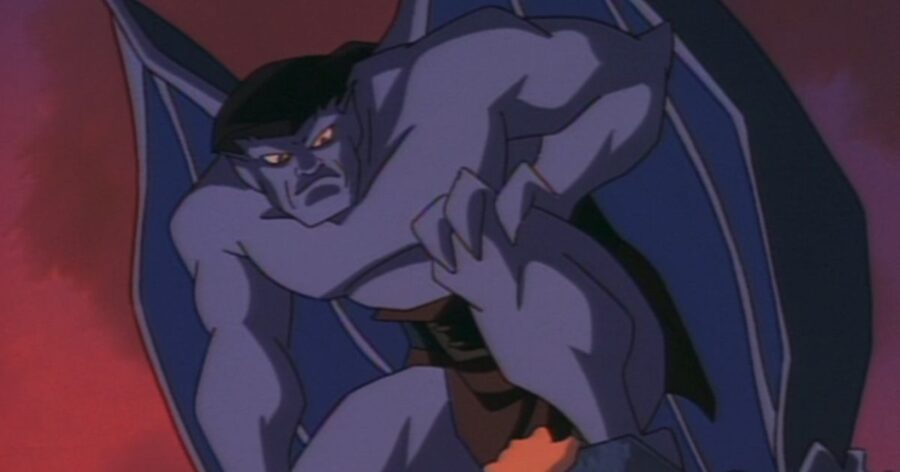In 2016, Rick Baker, the Oscar-winning makeup artist and creature creator behind Men in Black, An American Werewolf in London, and Tim Burton’s Planet of the Apes, auctioned off the monsters in his closet. Tucked away among the alien costumes and gremlins from Gremlins 2 were some curious bits of miscellanea related to an unproduced project: a live-action adaptation of Disney’s afternoon animated series, Gargoyles. In Baker’s collection were sketches, mock-ups, and an intricate, detailed maquette of main character, Goliath, with wings gloriously outstretched.
But how close was Disney to producing the Gargoyles movie? Close enough that one of Hollywood’s go-to screenwriters took a stab at writing the blockbuster at the end of his tenure with Disney. Having read the script, and after speaking to the creatives who developed the project, it’s clear that the film would have shocked audiences in comparison to what Disney was producing at the time.
Gargoyles brought the edginess and maturity of the popular Batman: The Animated Series to Disney Afternoon’s 1994 syndicated programming block. Incorporating Celtic mythology and Shakespearean grandeur, the show followed a group of mythic Gargoyles (led by Goliath, voiced by Keith David) who were turned to stone 1,000 years ago and wake up in current-day New York City. Between rich animation and episodes that tackled adult themes, like an infamous episode involving an accidental shooting, the show lured in both a young and adult crowd. (It didn’t hurt that the voice cast was littered with Star Trek: The Next Generation alums). As cool as Gargoyles was — and to be sure, it was really fucking cool — ratings were never through-the-roof, and after some creatives shuffles and a rebranding attempt, with season 2 dubbed “Gargoyles: The Goliath Chronicles,” the show quietly concluded in early 1997.
Still, the core idea of stone gargoyles reawakening in modern Manhattan was too delicious to completely abandon. And one way to keep it alive was a live-action feature.
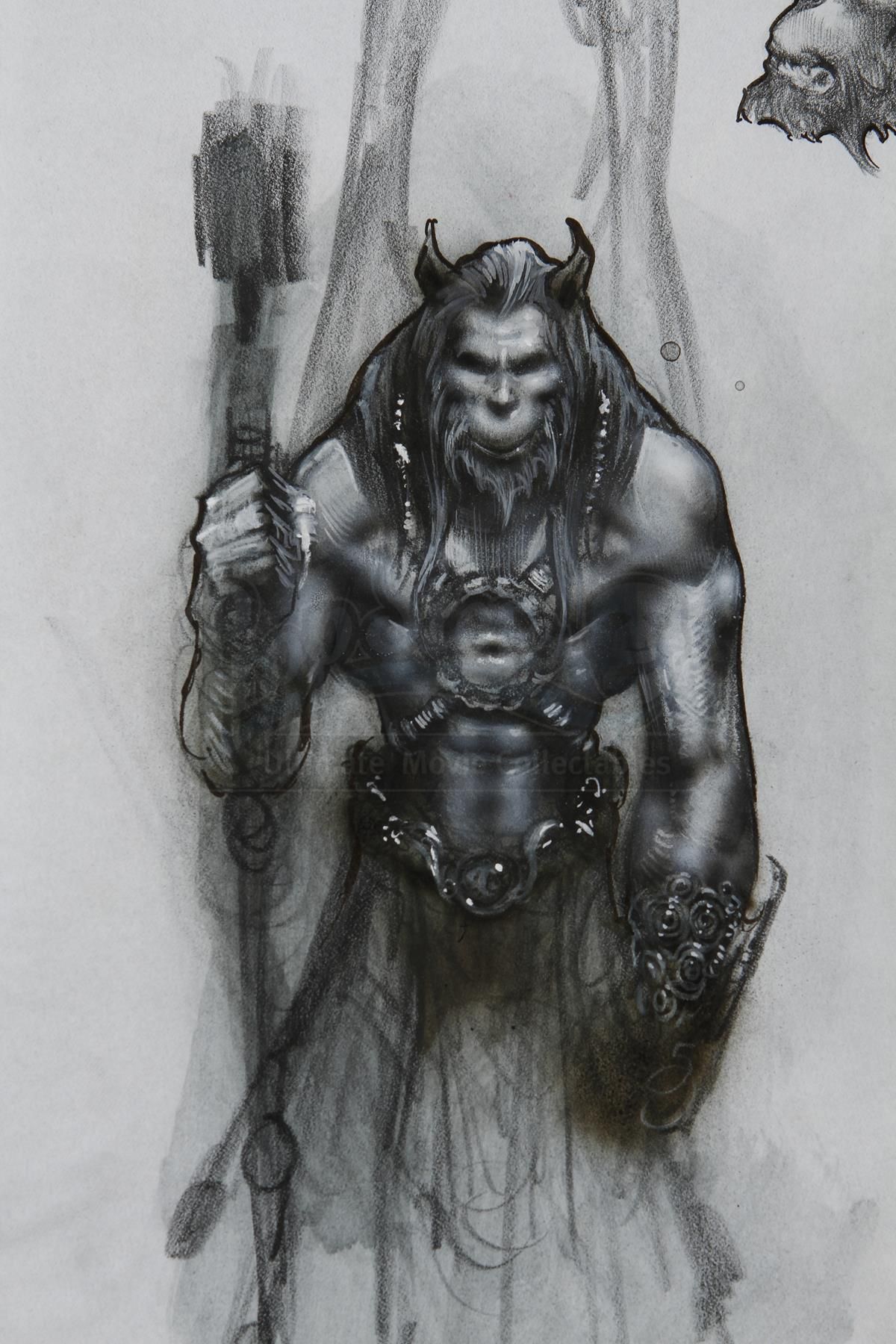

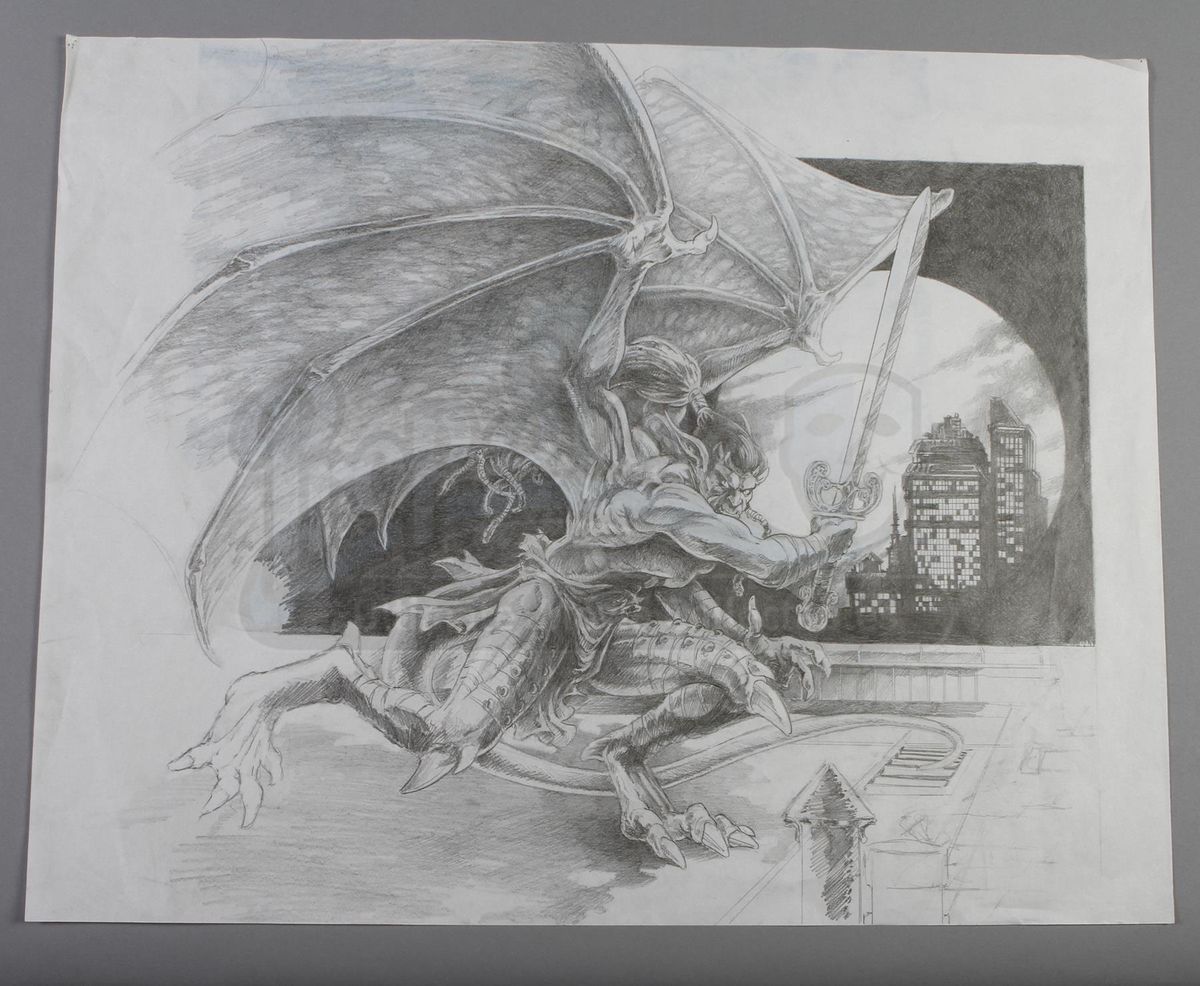
Images: Courtesy of Prop Store
According to Greg Weisman (Young Justice), a former Disney executive who oversaw Gargoyles, a live-action feature adaptation of the animated series was talked about almost from the beginning of the series’ run. Todd Garner, then an executive at Disney’s more adult-skewering label Touchstone Pictures, and now the independent producer of such hits as the ultra-violent Mortal Kombat remake, wanted to convert the series into a live-action movie as early as 1995, according to Weisman’s post. Garner confirmed the timeline to Polygon, but unlike the more considered, synergistic machinations of the current Disney company, which builds tentpole events around key “corporate priorities” that can be supported by every business unit, the executive and Disney studio chief Joe Roth were just searching for something cool to make.
“We were looking through all of our IP,” Garner says. “That’s when we did Pirates of the Caribbean. That’s when we started thinking about The Haunted Mansion movie. There was even an animated idea that was floating around that they were going to do with all the villains.” (He notes that Roth eventually got his villain idea to the screen in the form of the live-action Maleficent and Alice in Wonderland movies.) Gargoyles appealed to Garner, who enjoyed the series’ mixture of Gothic elements and superhero tropes. “We would always say, ‘Why aren’t we making Indiana Jones? Why aren’t we making Star Wars? Why aren’t we making these movies?’ All the stuff’s in the park,” referring to the Star Tours and Indiana Jones and the Temple of the Forbidden Eye attractions at Disneyland.
Garner then teamed with Gary Krisel, then President of Walt Disney Television Animation, and producer Tom Jacobson, who would produce projects like the big-budget Mighty Joe Young remake, Mission to Mars, based on the Disney theme park attraction, and the Coen bros.’ Tom Hanks-led Ladykillers remake. Krisel, in turn, suggested Weisman and Michael Reaves, a fellow producer and co-creator on Gargoyles who had written most of the first season (and was a veteran of Batman: The Animated Series), to take a crack at the screenplay. Together, they reconfigured and condensed the show’s epic pilot, “Awakening,” which aired over five parts in 1995. This version was not embraced at Touchstone, as a greater turmoil embraced the company.
The producing team later commissioned a draft from screenwriter Dean Devlin, who was coming off the massive success of Independence Day. While Devlin’s draft didn’t totally gel, according to Garner, it proved that the concept could work as a big budget live-action spectacle and didn’t need the dense mythological underpinnings that moored the animated series. So the studio brought in screenwriter Jim Kouf, who at that time was a Disney superstar. In his 14 years writing for the studio, Kouf penned Stakeout, Disorganized Crime (which he also directed), Operation Dumbo Drop, Another Stakeout, and the script that would become National Treasure. (He also wrote Rush Hour for Disney, but when leadership scoffed at proposed leading man Jackie Chan, he took it to New Line Cinema, and in the process spawned a nearly $1 billion franchise.) As part of his overall deal, Kouf also provided uncredited script work on live-action Disney projects like The Rocketeer, The Rock, White Fang and Con Air. “I did four to five scripts a year for them,” Kouf tells Polygon. “It was like old Hollywood.”
Kouf was the studio’s “go-to action guy at the time.” If anybody could make Gargoyles take flight, Garner says, it was him. Dated April 10, 1998, Kouf’s “Second Revision First Draft” version of Gargoyles for Disney was closer to Seven than Snow White and the Seven Dwarfs. Set mostly in a moody, perpetually rain-slicked New York City, it is immediately clear that the core concept was really all that anybody wanted to maintain.

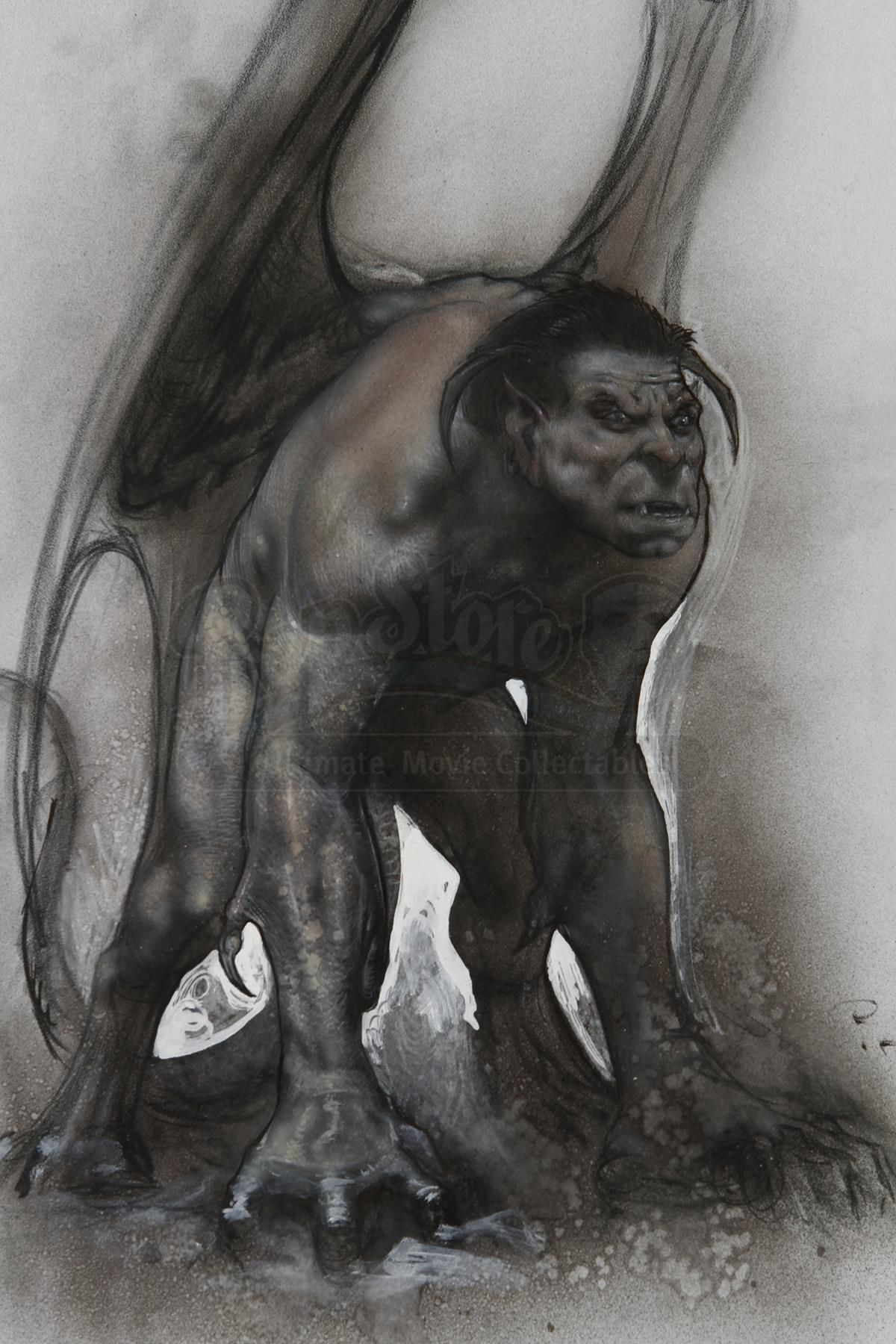
Images: Courtesy of Prop Store
The script begins, as so many fantasies do, with bold text: “AN ANCIENT TIME … A TIME OF MAGIC … A THOUSAND YEARS AGO.” Kouf introduces Goliath MacGrath, a warrior whose land is being threatened by an evil sorcerer named Morgan. Morgan is poised to open up a portal to hell, so Goliath visits a sorcerer, who promises to give him a much-needed supernatural upgrade, by transforming him and some other warriors into undefeatable creatures. “You must give up your flesh and blood and your heart will be turned to stone,” the sorcerer tells him. “But you will not be dead. You will be more powerful than a hundred men and be feared by all […] And looked upon as the devil himself.” So there’s a trade-off. Unwilling to return to his family in his monstrous form, the sorcerer repeats a refrain familiar to fans of the show: “Stone you will be and stone you shall remain … until such time as you have been raised above the clouds in the heavens.” It’s then that he can return to life, in gargoyle form. The gargoyles — along with Goliath there is Calum, Allig, Ruairidh, Tormod and Domhnall — defeat the evil Morgan and promptly turn into stone.
The action then jumps to “present day.” In Northern Chile, we meet Alex Anderson, Goliath’s long lost relative, who is working in a mine. With shades of William Friedkin’s Sorcerer, Kouf paints a picture of a rugged adventurer type who makes a big show out of returning a letter to his father (who lives in Manhattan), unread. From there, the action heads to New York, where Alex’s father has made arrangements for a gargoyle to be hoisted onto the awning outside his Manhattan high rise. At the same time, there are a series of grisly murders, framed as suicides, that are accompanied by ghoulish creatures. It turns out that – surprise! – Morgan is back and is still determined to open that gate to hell, this time in New York, with the help of the physical manifestations of vices like Despair, Malice, Restlessness, Cowardice and Debauchery (think the “sins” in DC’s Shazam movie). When Alex’s father falls victim to this dark plot, he returns to New York, where he partners with Detective Brenna, a young detective who seems to be a surrogate for the series’ human heroine Elisa Maza, who is investigating Alex’s father’s death (and some of the other deaths). Oh, and almost as soon as Alex gets there, the large gargoyle installed outside of his father’s apartment springs to life.
The introduction of Goliath in New York City, about 36 pages in, is spectacular. The crate housing the gargoyle explodes, sending Alex tumbling over the guardrail. Goliath saves him and takes off, careening through the city. He crashes into buildings, sends air conditioning units plummeting to the ground, snaps power lines, phone lines, and cable lines. He smashes into a water tower, leading to a humorous interlude where two posh New Yorkers, in the dead of winter, are doused in freezing water. (There’s also a fun moment where Goliath comes face-to-face with an actual gargoyle.) This goes on for pages. Eventually, Goliath, Alex, who remembers tales his father once told him of this very legend, and Brenna team up to take down Morgan and his goons. (Morgan, in the intervening years, had destroyed the other gargoyles while they were still asleep and in their stone state.) At the end of the script, Goliath, having vanquished Morgan, resides at the bottom of a river. But the gargoyles that Morgan had destroyed are now reformed, resting alongside him. Tantalizingly, the script ends with the words: “Reunited. Someday, maybe to rise again. When there is no one left who believes.”
This Gargoyles script is fun to read, even at an overstuffed 127 pages. This is a script full of grand action set pieces, sly humor, and a nifty, Christmastime setting. There are also occasionally baffling creative decisions, like the fact that Goliath only speaks Gaelic and Alex only speaks English. With bursts of extreme violence, plus drinking, cursing (Alex calls Morgan an “ugly piece of shit from hell”), and smoking, Kouf packed his script full of things that are forbidden in most all-ages, four-quadrant Disney fare. “We weren’t doing it for kids,” Garner says. “We were trying to do what Marvel eventually ended up doing so well.”
By the time Kouf began work on Gargoyles, his relationship with Disney was coming to an end. the writer was labeled a “Katzenberg guy,” and the assignments weren’t coming as steadily as they had before. He knew his days were numbered. Still, he took the assignment. Kouf recalls Disney wanting to get away from Devlin’s take on the material (“I remember it had gargoyles in it”), and his wild departures from the animated series were at the request of executives, who had questions. “They were trying to explain: What do these gargoyles do? Who are they?” Kouf says. “I didn’t deviate from anything they wanted. We had lots of discussions about what to do and what not to do, and where they wanted to take it. And I tried to stick with what they were guiding me on.” As to the dark, gritty nature of the material, Kouf says it was something that was encouraged but could have led to the project’s downfall. “It might’ve been too tough for Disney at the time.”
Kouf’s work on Gargoyles does not rank amongst the most creative experiences in his long and storied career. “I didn’t come in with a bunch of ideas. They just hired me to fix it,” Kouf says. He had no familiarity with the source material, only watching the original animated series after he got the job, “just to familiarize himself.” So instead of being wed to this beloved cartoon and its ever-deepening mythology, Kouf treated it as “just another job.” The edict was simple: “Let’s make this a hard-hitting movie and have fun with it.” His rewrite of Devlin’s Gargoyles script boosted Disney’s confidence enough to hire Rick Baker to begin imagining how the movie would translate to live-action.
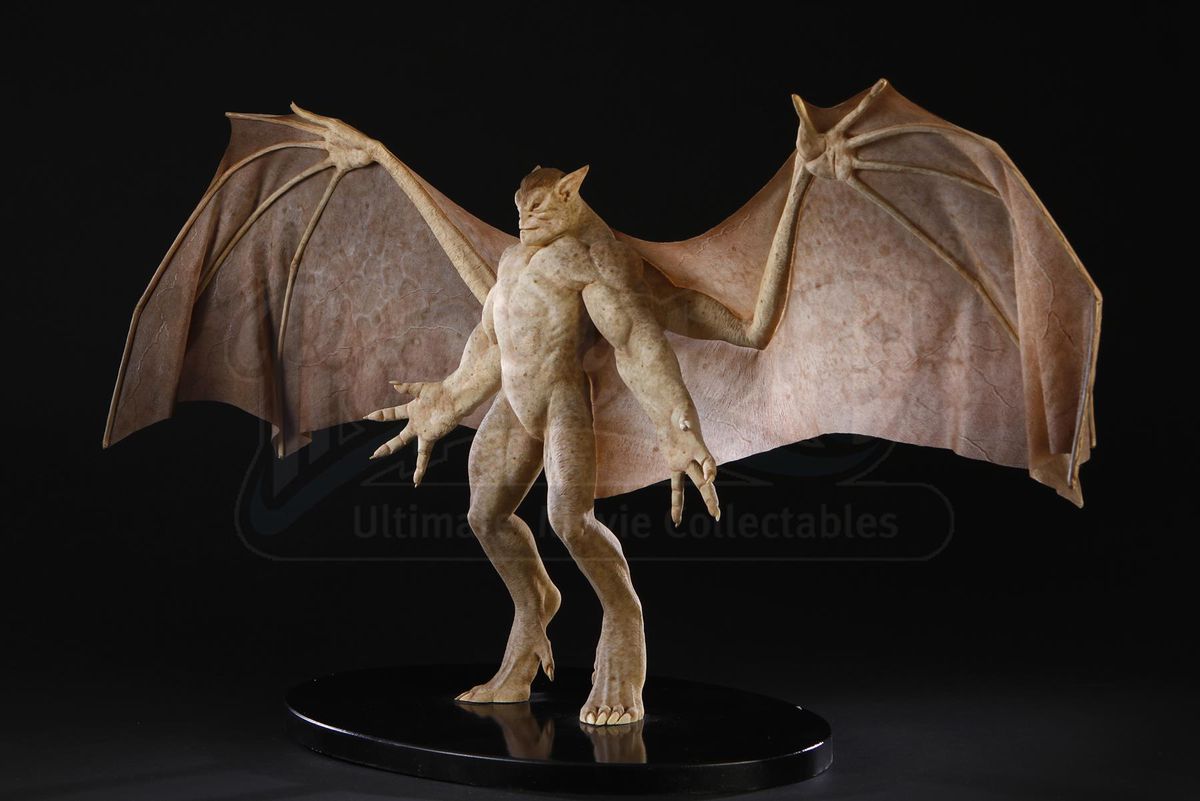
Image: Courtesy of Prop Store
Around the time his work on Gargoyles ended, Kouf had lost his office on the Disney lot. And while development progressed on the project, including pre-production meetings and preliminary design work, energy seemed to be dissipating. (Kouf never met with Baker, but would eventually become his neighbor in Los Angeles.) There was another thing going against Gargoyles: it would have been an extremely complicated and expensive shoot, from the sequences of Goliath flying around Manhattan to the bigger battle set pieces. “It wouldn’t have been easy,” Kouf says. Scale and ‘90s technology seems to have been the true cause of Gargoyles’ downfall.
Garner confirms that the Kouf script got them the furthest. It was his draft that merited the Baker maquettes and mock-ups. “I took it to the greenlight committee,” Garner says. At the time he was involved with another Disney project that would ultimately drown in the quagmire of unproven technology and increasingly astronomical budgets – Gemini Man. Disney had Mel Gibson signed, and hoped to use a combination of footage from Mad Max and extensive make-up appliances for the story of an aging hitman getting tracked by his younger self. Eventually the film was made at Paramount by Ang Lee with Will Smith as the killer, his younger self brought to life by a fully computer-generated double. But at the time, more rudimentary practices were the only options. Even with Gargoyles whittling down the core group to a single creature, a decision Garner admits was based on the ballooning budget, the cost was still too much. “At the same time [as Gemini Man], we wanted to make Gargoyles, but we would have had them done it with guys in suits,” Garner said. “And we were like, ‘Ah, it’s just not there yet.’ The whole thing just sat there.” Eventually Garner and Roth left the studio, putting the final nail in the coffin of this version of the project.
Kouf, too, moved away from Gargoyles. He worked on a few other projects for Disney, including with the company’s secretive theme park design group Walt Disney Imagineering on a National Treasure-themed boat ride, but Gargoyles marked the end of an incredibly prolific and fun period of the writer’s life. Almost immediately after, he began working on TV, where he would contribute to shows like Angel and Ghost Whisperer and eventually co-create the long-running supernatural series Grimm. Periodically, Weisman would write about additional proposed versions of the movie, but there has been no real movement and no official commitment to resurrect the property. A few years ago, Jordan Peele supposedly asked Disney about doing a live-action movie. The studio didn’t go forward with his proposal.
With Gargoyles on Disney Plus, and the fanbase as passionate as ever, there’s always a chance the property could come back to life. Garner hasn’t lost any enthusiasm for developing the property. “It was going to be really hard to do the movie. And I’ve always loved it. I always thought they should do it as a movie.”
Polygon – All
Source link
Related Post:
- Scarlett Johansson sues Disney over Black Widow’s Disney Plus release
- Review: Gargoyles board game is great, just needs more Keith David
- How to watch Loki on Disney Plus without marathoning every Marvel movie
- Cruella director explains the shocking, not-so-Disney Dalmatian scene
- Please Do Not Buy Disney And Marvel’s Spider-Man NFTs
- Sony: Nurturing Creative Talent Is Not as Simple as Throwing Money At It
- how parkour and creative combat fuel the action – PlayStation.Blog
- Dead Space Remake Will Include Accessibility Options, Says Creative Director
- Borderlands Movie Has Finished Filming With First Look At Claptrap In Action
- Best PS4 Kids Games – Push Square
